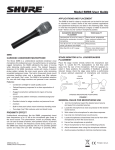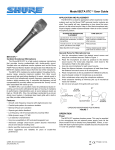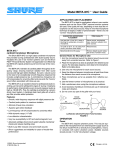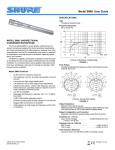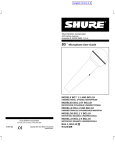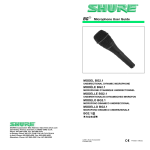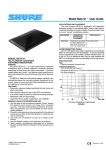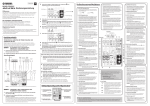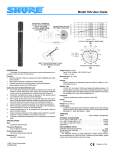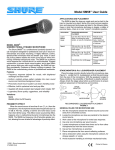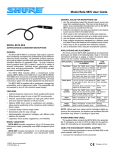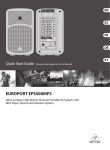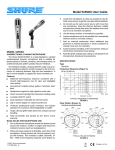Download Shure ULX2/SM86 User's Manual
Transcript
Model SM86 User Guide APPLICATIONS AND PLACEMENT The SM86 is ideal for close-up vocals and can be held in the hand or mounted on a stand. Some of the most common applications and placement techniques are listed in the following table. Keep in mind that microphone technique is largely a matter of personal taste—there is no one “correct” microphone position. SUGGESTED MICROPHONE PLACEMENT TONE QUALITY Lips less than 15 cm (6 in.) away or touching the windscreen, on axis to microphone. Robust sound, emphasized bass, maximum isolation from other sources. 15 to 60 cm (6 in. to 2 ft.) away from mouth, just above nose height. Reduced bass. More than 60 cm (2 ft.) away. Thinner, more distant sound; noticeable levels of ambient noise. STAGE MONITOR & P.A. LOUDSPEAKER PLACEMENT SM86 CARDIOID CONDENSER MICROPHONE The Shure SM86 is a unidirectional (cardioid) condenser vocal microphone for professional use in live performance. An extremely rugged microphone, the SM86 withstands the rigors of touring while delivering studio-quality sound. The tailored frequency response of the SM86 reproduces vocals with clarity. A cardioid pickup pattern isolates the main sound source while minimizing unwanted background noise. The built-in three-point shock mount minimizes handling noise, and a two-stage pop filter reduces wind and breath “pop” noise. The SM86 is an excellent selection for use with both stage monitors and personal in-ear monitors. Place the stage monitor directly behind the microphone (see Figure 1). Locate the P.A. loudspeakers so that they point away from the rear of the microphone. With the speakers located in these positions, the possibility of feedback is greatly reduced. Always check the stage setup before a performance to ensure optimum placement of microphone and monitors. 90° STAGE MONITOR P.A. LOUDSPEAKERS 0° 180° Features: • Condenser cartridge for studio quality sound SOUND SOURCE MICROPHONE 90° • Tailored frequency response for a clear reproduction of vocals • Rugged construction withstands the rigors of touring sound • Cardioid polar pattern minimizes unwanted background noise • Excellent choice for stage monitors and personal in-ear monitors • Built-in three-point shock mount minimizes handling noise • Two-stage “pop” filter reduces wind and breath noise PROXIMITY EFFECT Unidirectional microphones, like the SM86, progressively boost bass frequencies up to 15 dB as the microphone gets closer to the sound source. This phenomenon, known as proximity effect, can be used to create a warmer, more powerful sound. To prevent excessive or “boomy” low frequency sound during close-up use, the SM86 bass response gradually rolls off. This provides greater control and helps the user take advantage of proximity effect. 2004, Shure Incorporated 27A3143 (Rev. 1) CARDIOID MICROPHONE POSITIONING FIGURE 1 GENERAL RULES FOR MICROPHONE USE 1. Aim the microphone toward the desired sound source and away from unwanted sources. 2. Locate the microphone as close as practical to the desired sound source. 3. Work close to the microphone for extra bass response. 4. Use only one microphone per sound source. 5. Locate microphones at least three times as far from other microphones as from the sound source. 6. Use as few microphones as practical. 7. Place microphones far from sound-reflecting surfaces. 8. Add a windscreen when using the microphone outdoors. 9. Avoid excessive handling to minimize mechanical noise. Printed in U.S.A. Dynamic Range (1000 Ω) OPERATION 124 dB (maximum SPL to A-weighted noise level) Power Signal-to-Noise Ratio The SM86 requires phantom power. This may be supplied to the microphone from an external power supply (such as the Shure model PS1A) or directly from preamplifiers, mixers, or consoles with built-in phantom power. Suitable sources should provide 11 to 52 Vdc phantom voltage. 71 dB at 94 dB SPL (IEC 651)* *S/N ratio is difference between 94 dB SPL and equivalent SPL of self– noise A-weighted. Polarity Positive pressure on diaphragm produces positive voltage on pin 2 relative to pin 3 of the output connector. See Figure 4. Impedance A load impedance of at least 600 Ohms is recommended. The load may be as low as 150 Ohms, but a reduction in output level and output clipping level will result. CAPACITOR (ELECTRET CONDENSER) CARTRIDGE BLACK SPECIFICATIONS GREEN FET IMPEDANCE CONVERTER LF RESPONSE FILTER Transducer Type DISCRETE CLASS A AMPLIFIER RFI FILTER 2 1 3 REVERSE VOLTAGE PROTECTOR Condenser (electret bias) Frequency Response 50 to 18,000 Hz (see Figure 2) SM86 BLOCK DIAGRAM FIGURE 4 Power Phantom Supply Requirement . . . . . . . . 11 to 52 Vdc, positive at both pins 2 and 3 Current Drain . . . . . . . . . . . . . . . . . . . . . . . . . . . . . . . . . . 5.2 mA dB +10 0 Connector Three–pin (XLR) professional audio –10 Case 20 50 100 29 3 4 5 6 789 2 1000 Dark gray enamel-painted steel with matte-finished silver colored steel grille 3 4 5 6 78 9 10000 20000 Dimensions Hz See Figure 5 183 mm (7.2 in.) TYPICAL FREQUENCY RESPONSE FIGURE 2 Polar Pattern 24 mm (.95 in.) Cardioid (see Figure 3) 49 mm (1.92 in.) OVERALL DIMENSIONS FIGURE 5 Net Weight Net: 278 grams (9.8 oz) Environmental Conditions Operating: –18° to 60° C (0° to 135° F) (relative humidity <90%) Storage: –29° to 74° C (–20° to 165° F) (relative humidity <80%) CERTIFICATION 250 Hz 500 Hz 1000 Hz Eligible to bear CE Marking. Conforms to European EMC Directive 89/336/EEC. Meets applicable tests and performance criteria in European Standard EN55103 (1996) parts 1 and 2, for residential (E1) and light industrial (E2) environments. 2500 Hz 6400 Hz 10000 Hz TYPICAL POLAR PATTERN FIGURE 3 FURNISHED ACCESSORIES Break Resistant Microphone Clip . . . . . . . . . . . . . . . . A25D Microphone Bag . . . . . . . . . . . . . . . . . . . . . . . . . . . . . . 26A13 5/8” to 3/8” Thread Adapter . . . . . . . . . . . . . . . . . 31A1856 Output Impedance 150 Ohms at 1 kHz Recommended minimum load impedance: 600 Ohms Sensitivity (at 1,000 Hz) OPTIONAL ACCESSORIES Open Circuit Voltage . . . . . . . . . . . . . . . . –50 dBV/Pa (3.15 mV) (1 Pa = 94 dB SPL) Phantom Power Supply . . . . . . . . . . . . . . . . . . . . . . . . PS1A Shock Stopper Isolation Mount . . . . . . . . . A55M, A55HM Popper Stopper Windscreen . . . . . . . . . . . . . . . . A85WS 7.6 m (25 ft.) Cable . . . . . . . . . . . . . . . . . . . . . . . . . . . . C25F Output Clipping Level 1000 Ohm Load at 1,000 Hz . . . . . . . . . . . . . . +3 dBV (1.41 V) Maximum SPL (at 1,000 Hz) REPLACEMENT PARTS 1000 Ω load (1% THD) . . . . . . . . . . . . . . . . . . . . . . . . . . . 147 dB Screen and Grille Assembly . . . . . . . . . . . . . . . . . . RPM226 Cartridge and Shock Mount . . . . . . . . . . . . . . . . . . . RPM112 Replacement Amplifier Assembly . . . . . . . . . . . . . RPM410 Self-Noise 23 dB typical, A-weighted 2 MICROPHONE ÉLECTROSTATIQUE CARDIOÏDE SM86 PLACEMENT DES RETOURS DE SCÈNE ET HAUT–PARLEURS DE SONORISATION Le SM86 Shure est un microphone électrostatique unidirectionnel (à diagramme polaire cardioïde) pour la voix conçu pour une utilisation professionnelle en concert. Le SM86 est un microphone extrêmement robuste, conçu pour supporter les rigueurs des tournées tout en fournissant un son d’une qualité digne d’un enregistrement en studio. La réponse en fréquence étudiée du SM86 assure une reproduction claire de la voix. Le diagramme cardioïde permet d’isoler la source sonore principale tout en minimisant le bruit de fond indésirable. La monture silentbloc trois points intégrée minimise les bruits de manipulation et un filtre anti–pop à deux couches réduit les bruits de vent et de respiration. Le SM86 est un excellent choix pour être utilisé aussi bien avec les retours de scène que les systèmes de retour personnel (Ear Monitor). Placer le retour de scène directement derrière le microphone (voir figure 1). Situer les haut–parleurs de sonorisation de façon à ce qu’ils soient orientés à l’opposé de l’arrière du microphone. De cette manière, le risque d’effet Larsen est sensiblement réduit. Toujours vérifier la configuration de scène avant un spectacle pour s’assurer du placement optimum du microphone et des retours de scène. 90° RETOUR DE SCÈNE HAUT–PARLEURS DE SONORISATION EXTÉRIEURE Fonctions : • Capsule électrostatique pour un son d’une qualité digne d’un enregistrement en studio • Réponse en fréquence étudiée pour une reproduction claire de la voix • Construction robuste pour supporter les rigueurs des tournées • La courbe de directivité cardioïde minimise le bruit de fond indésirable • Excellent choix pour les retours de scène et les systèmes de retour personnel (Ear Monitor) • La monture silentbloc trois points intégrée minimise les bruits de manipulation • Le filtre anti–pop à deux couches réduit les bruits de vent et de respiration 90° POSITIONNEMENT D’UN MICROPHONE CARDIOÏDE FIGURE 1 RÈGLES GÉNÉRALES D’UTILISATION DU MICROPHONE 1. Diriger le microphone vers la source sonore désirée et à l’opposé des sources sonores indésirables. 2. Placer le microphone le plus près possible de la source sonore désirée. 3. Pour obtenir davantage de graves, placer le microphone le plus près possible de la source sonore. 4. Utiliser un seul microphone par source sonore. Les microphones unidirectionnels, comme le SM86, accentuent progressivement les fréquences graves jusqu’à 15 dB lorsque l’on rapproche le microphone de la source sonore. Ce phénomène, appelé effet de proximité, peut être souhaité pour obtenir un son plus chaud et plus puissant. Pour prévenir un excès de fréquences graves quand le microphone est très près de la bouche, le SM86 intègre une atténuation progressive des basses fréquences. Cela permet un meilleur contrôle du son et aide l’utilisateur à profiter de l’effet de proximité. 5. Placer les microphones adjacents à une distance triple de celle séparant les microphones de la source sonore. 6. Utiliser le moins de microphones que possible. 7. Placer les microphones le plus loin possible des surfaces réfléchissant le son. 8. Si le microphone est utilisé à l’extérieur, le munir d’une bonnette anti–vent. APPLICATIONS ET PLACEMENT 9. Éviter la manipulation excessive pour minimiser les bruits mécaniques. Le SM86 est idéal pour la captation des voix en proximité et peut être tenu à la main ou monté sur un pied. Certaines des applications et techniques de placement les plus communes sont répertoriées dans le tableau suivant. Ne pas oublier que la façon d’utiliser un microphone est souvent une question de goût personnel—il n’existe aucune position de microphone « correcte » à proprement parler. UTILISATION Alimentation Le SM86 exige une alimentation fantôme. Le microphone peut être alimenté à partir d’un bloc d’alimentation externe (tel que le Shure modèle PS1A) ou directement à partir de préamplificateurs, mélangeurs ou consoles de mixage à alimentation fantôme intégrée. Les sources d’alimentation fantôme qui conviennent doivent fournir une tension entre 11 et 52 V c.c. QUALITÉ DU TIMBRE Lèvres à moins de 15 cm (6 po) de la bonnette anti–vent ou la touchant, dans l’axe du microphone. Son puissant, graves accentués, isolation maximum par rapport aux autres sources. 15 à 60 cm (6 po à 2 pi) de la bouche, juste au–dessus de la hauteur du nez. Graves atténués. Plus de 60 cm (2 pi). Son plus ténu et plus distant, sensibilité aux bruits ambiants. SOURCE SONORE MICROPHONE EFFET DE PROXIMITÉ PLACEMENT SUGGÉRÉ DU MICROPHONE 0° 180° Impédance Une impédance de charge d’au moins 600 ohms est recommandée. La charge peut être d’un minimum de 150 ohms, mais cela entraînera une réduction du niveau de sortie et du seuil d’écrêtage en sortie. 3 Polarité CARACTÉRISTIQUES TECHNIQUES Une pression positive sur le diaphragme produit une tension positive sur la broche 2 par rapport à la broche 3 du connecteur de sortie. Voir figure 4. Type de transducteur Électrostatique (capsule électret) Réponse en fréquence CAPSULE (ÉLECTROSTATIQUE À ÉLECTRET) À CONDENSATEUR 50 à 18 000 Hz (voir figure 2) NOIR VERT TEC IMPÉDANCE CONVERTISSEUR BF RÉPONSE FILTRE FILTRE HF PROTECT. INVERS. POLARITÉ +10 dB DISCRET CLASSE A AMPLIFICATEUR SCHÉMA DE PRINCIPE DU SM86 FIGURE 4 0 Alimentation –10 20 50 100 29 3 4 5 6 789 2 1000 Tension d’alimentation fantôme 11 à 52 V c.c., positive aux broches 2 et 3 Consommation de courant . . . . . . . . . . . . . . . . . . . . . . . 5,2 mA 3 4 5 6 78 9 10000 20000 Connecteur Hz Audio professionnel à trois broches (XLR) COURBE DE RÉPONSE TYPIQUE FIGURE 2 Corps Acier peint vernis gris foncé à grille en acier de couleur argentée matte Courbe de directivité Dimensions Diagramme polaire cardioïde (voir figure 3) Voir figure 5 183 mm (7,2 po) 24 mm (0,95 po) 49 mm (1,92 po) DIMENSIONS HORS TOUT FIGURE 5 Poids net Net : 278 grammes (9,8 oz) 250 Hz 500 Hz 1000 Hz Environnement 2500 Hz 6400 Hz 10 000 Hz Fonctionnement : –18 à 60 °C (0 à 135 °F) (humidité relative <90%) Stockage : –29 à 74 °C (–20 à 165 °F) (humidité relative <80 %) HOMOLOGATION COURBE DE DIRECTIVITÉ TYPIQUE FIGURE 3 Autorisé à porter la marque CE. Conforme à la directive CEM européenne 89/336/CEE. Conforme aux critères applicables de test et de performances de la norme européenne EN55103 (1996) parties 1 et 2 pour les environnements résidentiels (E1) et d’industrie légère (E2). Impédance de sortie 150 ohms à 1 kHz Impédance de charge minimum recommandée : 600 ohms Sensibilité (à 1 000 Hz) ACCESSOIRES FOURNIS Tension en circuit ouvert . . . . . . . . . . . . . –50 dBV/Pa (3,15 mV) (1 Pa = 94 dB SPL) Pince de microphone incassable . . . . . . . . . . . . . . . . A25D Pochette de rangement . . . . . . . . . . . . . . . . . . . . . . . 26A13 Adaptateur de filet 5/8 à 3/8 po. . . . . . . . . . . . . . . 31A1856 Niveau d’écrêtage de sortie Charge de 1000 ohms à 1000 Hz . . . . . . . . . . +3 dBV (1,41 V) ACCESSOIRES EN OPTION SPL maximum (à 1,000 Hz) Bloc d’alimentation fantôme . . . . . . . . . . . . . . . . . . . . . PS1A Pince micro à suspension Shock Stopper A55M, A55HM Bonnette anti–vent Popper Stopper . . . . . . . . . . A85WS Câble de 7,6 m (25 pi) . . . . . . . . . . . . . . . . . . . . . . . . . C25F 1000 Ω de charge (1 % DHT) . . . . . . . . . . . . . . . . . . . . . 147 dB Bruit propre 23 dB typique, pondéré en A PIÈCES DE RECHANGE Gamme dynamique (1000 Ω) Ensemble écran et grille . . . . . . . . . . . . . . . . . . . . . RPM226 Capsule et monture silentbloc . . . . . . . . . . . . . . . . . RPM112 Amplificateur de rechange . . . . . . . . . . . . . . . . . . . RPM410 124 dB (SPL maximum au niveau de bruit pondéré en A) Rapport signal/bruit 71 dB à 94 dB SPL (IEC 651)* *Le rapport S/B est la différence entre le SPL à 94 dB et le SPL équivalent du bruit propre pondéré A. 4 NIEREN–KONDENSATORMIKROFON SM86 ANORDNUNG VON BÜHNENMONITOR UND BESCHALLUNGSANLAGE Das Shure SM86 ist ein Kondensatormikrofon mit nierenförmiger Richtcharakteristik für Gesang, das für den professionellen Einsatz bei Live–Aufführungen entwickelt wurde. Es ist ein extrem robustes Mikrofon, das allen Beanspruchungen auf der Bühne gewachsen ist und dabei Klang in Studioqualität liefert. Der präzise abgestimmte Frequenzgang des SM86 ermöglicht eine gute Reproduktion von Gesangsstimmen. Die nierenförmige Richtcharakteristik erfasst die gewünschte Klangquelle, während unerwünschte Hintergrundgeräusche minimal bleiben. Der eingebaute Schockabsorber reduziert den Körperschall auf ein Minimum und ein zweistufiger Poppfilter reduziert Wind– und Atemgeräusche. Das SM86 eignet sich hervorragend zur Verwendung mit Bühnenmonitoren und In–Ear–Monitorsystemen. Den Bühnenmonitor direkt hinter dem Mikrofon anordnen (siehe Abbildung 1). Die Beschallungsanlage so aufstellen, dass sie von der Rückseite des Mikrofons weg weist. Wenn die Lautsprecher so angeordnet sind, ist die Gefahr akustischer Rückkopplung stark reduziert. Vor jeder Aufführung sollte die Aufstellung auf der Bühne überprüft werden, um die optimale Anordnung von Mikrofon und Monitoren zu gewährleisten. 90° BÜHNENMONITOR BESCHALLUNGSANLAGE (PA) 0° 180° Technische Eigenschaften: • Kondensatorkapsel mit Klang in Studioqualität • Präzise angepasster Frequenzgang für saubere Reproduktion von Gesang • Robuste Konstruktion, die den Beanspruchungen der Bühne gewachsen ist • Nierenförmige Richtcharakteristik minimiert unerwünschte Hintergrundgeräusche • Hervorragende Wahl bei Verwendung mit Bühnenmonitoren und In–Ear–Monitorsystemen • Eingebauter Schockabsorber minimiert Körperschall • Zweistufiger Poppfilter verringert Wind– und Atemgeräusche SCHALLQUELLE MIKROFON 90° PLATZIERUNG EINES NIERENMIKROFONS ABBILDUNG 1 ALLGEMEINE REGELN FÜR DEN MIKROFONGEBRAUCH 1. Das Mikrofon auf die gewünschte Schallquelle und weg von unerwünschten Schallquellen richten. 2. Das Mikrofon so nahe wie möglich an der gewünschten Schallquelle aufstellen. 3. Das Mikrofon sehr nahe platzieren, um eine zusätzliche Bassanhebung zu erzielen. 4. Nur ein Mikrofon je Schallquelle verwenden. 5. Das Mikrofon sollte mindestens drei Mal so weit von anderen Mikrofonen als von der Schallquelle entfernt sein. 6. So wenig Mikrofone wie möglich verwenden. 7. Die Mikrofone möglichst weit von schall–reflektierenden Flächen anordnen. 8. Bei Einsatz des Mikrofons im Freien einen Windschutz anbringen. 9. Das Mikrofon möglichst ruhig halten, um mechanische Störgeräusche zu vermeiden. NAHBESPRECHUNGSEFFEKT Gerichtete Mikrofone wie das SM86 verstärken bei Näherung des Mikrofons an die Klangquelle tiefe Frequenzen bis zu 15 dB. Diese Eigenschaft wird als Nahbesprechungseffekt bezeichnet und kann zum Erzeugen eines wärmeren, kräftigeren Klangs verwendet werden. Zur Verhinderung von übermäßigen oder „dröhnenden“ niederfrequenten Klängen weist das SM86 einen Frequenzgang mit Hochpass auf. Dies bietet eine einfachere Klangkontrolle und hilft dem Benutzer, sich den Nahbesprechungseffekt zu Nutze zu machen. VERWENDUNG UND PLATZIERUNG Das SM86 ist ideal für Gesangsnahaufnahmen und kann in der Hand gehalten oder an einem Stativ angebracht werden. Einige der gebräuchlichsten Anwendungen und Platzierungsverfahren sind in der nachstehenden Tabelle aufgeführt. BETRIEB Spannungsversorgung EMPFOHLENE MIKROFONPLATZIERUNG KLANGQUALITÄT Lippen weniger als 15 cm entfernt oder berühren den Windschutz, axial zum Mikrofon. Robuster Klang, betonter Bass, maximale Trennung von anderen Schallquellen. Das SM86 benötigt Phantomspeisung. Das Mikrofon kann durch ein externes Netzteil (wie z.B. das Modell Shure PS1A) oder direkt von Vorverstärkern oder Mischpulten mit eingebauter Phantomspeisung versorgt werden. Die Phantomspeisungsspannung muss minimal 11 V, maximal 52 V DC betragen. 15 bis 60 cm vom Mund entfernt, unmittelbar über Nasenhöhe. Verringerter Bass. Impedanz Über 60 cm entfernt. Dünnerer, entfernterer Klang; wahrnehmbare Umgebungsgeräusche. Eine Abschlussimpedanz von mindestens 600 Ohm wird empfohlen. Die Abschlussimpedanz kann bis auf 150 Ohm verringert werden; dies führt allerdings zu einer Verringerung des Ausgangspegels und des Übersteuerungspegels. 5 Polarität TECHNISCHE DATEN Positiver Druck an der Membran erzeugt positive Spannung an Pin 2 in Bezug auf Pin 3 des Ausgangs. Siehe Abbildung 4. Wandlertyp Kondensatormikrofon (Elektret) KONDENSATORKAPSEL (ELEKTRETKONDENSATOR) Frequenzgang 50 bis 18.000 Hz (siehe Abbildung 2) SCHWARZ GRÜN BASS– FET– IMPEDANZ– WANDLER FREQUENZGANG– FILTER FUNKSTÖRUNGSFILTER 2 1 3 GEGEN– SPANNUNGS– SCHUTZ +10 dB DISKRETER KLASSE A VERSTÄRKER BLOCKSCHALTBILD DES SM86 ABBILDUNG 4 0 Spannungsversorgung –10 20 50 100 29 3 4 5 6 789 2 1000 Erforderliche Phantomspeisungsspannung11 bis 52 V DC, positiv an beiden Pins 2 und 3 Stromaufnahme . . . . . . . . . . . . . . . . . . . . . . . . . . . . . . . . 5,2 mA 3 4 5 6 78 9 10000 20000 Stecker Dreipolig, XLR Hz TYPISCHER FREQUENZGANG ABBILDUNG 2 Gehäuse Stahl mit dunkelgrauem Emailanstrich und mattsilbernem Stahlgrill Richtcharakteristik Gesamtabmessungen Nierenförmig (siehe Abbildung 3) Siehe Abbildung 5 183 mm (7,2 Zoll) 24 mm (0,95 Zoll) 49 mm (1,92 Zoll) GESAMTABMESSUNGEN ABBILDUNG 5 Nettogewicht Netto: 278 g 250 Hz 500 Hz 1000 Hz Temperaturbereich 2500 Hz 6400 Hz 10.000 Hz Betrieb: –18 bis 60 °C (relative Luftfeuchtigkeit <90 %) Lagerung: –29 bis 74 °C (relative Luftfeuchtigkeit <80 %) TYPISCHE RICHTCHARAKTERISTIK ABBILDUNG 3 ZERTIFIZIERUNG Zur CE–Kennzeichnung berechtigt. Entspricht der europäischen Richtlinie zur elektromagnetischen Verträglichkeit 89/336/EWG. Erfüllt die Prüfungs– und Leistungskriterien der europäischen Norm EN 55103 (1996) Teil 1 und 2 für Wohngebiete (E1) und Leichtindustriegebiete (E2). Ausgangsimpedanz 150 Ohm bei 1 kHz Empfohlene Mindestabschlussimpedanz: 600 Ohm Empfindlichkeit (bei 1000 Hz) Leerlaufspannung . . . . . . . . . . . . . . . . . . –50 dBV/Pa (3,15 mV) (1 Pa = 94 dB Schalldruckpegel) MITGELIEFERTES ZUBEHÖR Bruchfeste Mikrofonklammer . . . . . . . . . . . . . . . . . . . . A25D Mikrofontasche . . . . . . . . . . . . . . . . . . . . . . . . . . . . . . . 26A13 5/8 zu 3/8 Inch Gewindeadapter . . . . . . . . . . . . . . 31A1856 Übersteuerungspegel An 1000 Ohm Last bei 1000 Hz . . . . . . . . . . . +3 dBV (1,41 V) Maximaler Schalldruckpegel (bei 1000 Hz) SONDERZUBEHÖR 1000 Ω Last (1 % Gesamtklirrfaktor) . . . . . . . . . . . . . . . 147 dB Phantomspeisegerät . . . . . . . . . . . . . . . . . . . . . . . . . . . PS1A Shock Stopper Schockabsorber . . . . . . . . A55M, A55HM Popper Stopper Windschutz . . . . . . . . . . . . . . . . . A85WS Kabel 7,6 m (25 Fuß) . . . . . . . . . . . . . . . . . . . . . . . . . . C25F Eigenrauschen typisch 23 dB(A) Dynamikbereich (1000 Ω) 124 dB (Differenz zwischen maximalem Schalldruckpegel und A–bewertetem Geräuschpegel) ERSATZTEILE Korb mit Windschutz . . . . . . . . . . . . . . . . . . . . . . . . RPM226 Kapsel– und Erschütterungsabsorber . . . . . . . . . . RPM112 Vorverstärker–Baugruppe . . . . . . . . . . . . . . . . . . . RPM410 Signalrauschabstand 71 dB bei 94 dB Schalldruckpegel (IEC 651)* *Signalrauschabstand ist die Differenz zwischen 94 dB Schalldruckpegel und dem äquivalenten Schalldruckpegel des A–bewerteten Eigenrauschens. 6 MICROFONO DE CONDENSADOR DE CARDIOIDE SM86 COLOCACION DE ALTAVOCES DE MONITOREO Y DEL SISTEMA DE REPRODUCCION El Shure SM86 es un micrófono para vocalistas de condensador unidireccional (de cardioide) diseñado para uso profesional en presentaciones en vivo. El SM86 es un micrófono extremadamente resistente, y ha sido diseñado para soportar los rigores de las giras a la vez que entrega sonido de calidad de estudio. La respuesta de frecuencias del SM86 ofrece una reproducción clara de la voz cantada. El patrón de captación de cardioide aísla la fuente sonora principal a la vez que reduce al mínimo los ruidos de fondo. El montaje amortiguado de tres puntos incorporado reduce al mínimo los ruidos de manipulación, y el filtro contra chasquidos de dos etapas reduce los ruidos del viento y del aliento. El SM86 es una alternativa excelente para usarse tanto con monitores en escenario como monitores personales de oído. Coloque el altavoz de monitoreo directamente detrás del micrófono (vea la Figura 1). Coloque los altavoces del sistema de reproducción de manera que el sonido que emiten se aleje de la parte trasera del micrófono. Cuando los altavoces se colocan en estas posiciones, la posibilidad de silbidos se reduce significativamente. Siempre compruebe la disposición del escenario antes de una ejecución para verificar que la colocación del micrófono y los altavoces de monitoreo es la óptima. 90° ALTAVOZ DE MONITOREO Características: ALTAVOCES DEL SISTEMA DE REPRODUCCION • Cápsula de condensador para sonido de calidad de estudio • Respuesta de frecuencia ajustada para una reproducción clara de la voz cantada • Fabricación resistente diseñada para soportar los rigores de las giras • El patrón polar de cardioide reduce al mínimo los ruidos de fondo no deseados • Excelente alternativa para monitores en escenario y monitores personales de oído • El montaje amortiguado de tres puntos incorporado reduce al mínimo los ruidos de manipulación • El filtro contra chasquidos de dos etapas reduce los ruidos producidos por el viento y el aliento 0° 180° FUENTE SONORA MICROFONO 90° COLOCACION DEL MICROFONO DE CARDIOIDE FIGURA 1 REGLAS GENERALES DE USO DE MICROFONOS 1. Apunte el micrófono hacia la fuente sonora deseada y alejado de las fuentes no deseadas. 2. Coloque el micrófono lo más cerca posible a la fuente sonora deseada. EFECTO DE PROXIMIDAD 3. Acérquese al micrófono para obtener mayor respuesta de frecuencias bajas. Los micrófonos unidireccionales, tales como el SM86, amplifican progresivamente las frecuencias bajas hasta por 15 dB, a medida que el micrófono se aproxima a la fuente sonora. Este fenómeno, conocido como el efecto de proximidad, puede usarse para crear un sonido más cálido y fuerte. Para evitar sonidos de baja frecuencia con intensidad explosiva o retumbante al usar el micrófono de cerca, el SM86 tiene una atenuación progresiva en su respuesta de bajos. Esto ofrece mayor control sobre el sonido y ayuda al usuario a aprovechar el efecto de proximidad. 4. Utilice sólo un micrófono para captar una fuente sonora. 5. La distancia entre un micrófono y otro deberá ser al menos tres veces la distancia de cada fuente a su micrófono. 6. Utilice el menor número de micrófonos que resulte práctico. 7. Aleje los micrófonos lo más posible de las superficies reflectoras de sonido. USOS Y COLOCACION 8. Instale un paravientos si se usa el micrófono a la intemperie. El SM86 es ideal para captar voces a corta distancia y puede sostenerse en la mano o en un pedestal. Algunas de las técnicas más comunes de uso y colocación se indican en la tabla siguiente. Recuerde que la técnica de uso de los micrófonos es en gran parte cuestión de gusto personal; no existe una posición de micrófono que sea la “correcta”. 9. Evite el manejo excesivo para reducir la captación de ruidos mecánicos. USO Alimentación COLOCACION SUGERIDA DEL MICROPHONO CALIDAD DEL TONO Los labios a menos de 15 cm (6 pulg) o tocando el paravientos, en línea con el eje de captación del micrófono. Sonido robusto, frecuencias bajas enfatizadas, aislamiento máximo de otras fuentes sonoras. De 15 a 60 cm (6 pulg a 2 pies) de la boca, justo por encima del nivel de la nariz. Respuesta reducida a frecuencias bajas. Impedancia Más de 60 cm (2 pies) de distancia. Sonido más agudo y distante; niveles perceptibles de sonido ambiental. Se recomienda usar una impedancia de carga de al menos 600 Ohmios. Se puede usar una carga mínima de 150 Ohmios, en cuyo caso se experimentará una reducción de la intensidad de la señal de salida y de su nivel de limitación. El SM86 requiere alimentación Phantom. Esta puede ser suministrada al micrófono desde una fuente externa (tal como la fuente Shure PS1A) o directamente desde los preamplificadores, consolas mezcladoras o consolas con capacidad de suministro de alimentación Phantom. Las fuentes adecuadas deberán suministrar un voltaje de alimentación Phantom de 11 a 52 VCC. 7 Polaridad ESPECIFICACIONES Una presión positiva en el diafragma del micrófono produce un voltaje positivo en la clavija 2 con respecto a la clavija 3 del conector de salida. Vea la Figura 4. Tipo de transductor Condensador (electreto polarizado) Respuesta de frecuencia CAPSULA DE CONDENSADOR (DE ELECTRETO) 50 a 18.000 Hz (vea la Figura 2) NEGRO VERDE CONVERTIDOR DE IMPEDANCIA FET FILTRO DE RESPUESTA DE BAJA FREQUENCIA AMPLIFICADOR CLASSE A DISCRETO 2 1 3 PROTECTOR CONTRA INVERSION DE VOLTAJE +10 dB FILTRO DE RFI 0 DIAGRAMA EN BLOQUES DE SM86 FIGURA 4 Alimentación –10 20 50 100 29 3 4 5 6 789 2 1000 Alimentación Phantom requerida 11 a 52 VCC, positivo en las clavijas 2 y 3 Consumo de corriente . . . . . . . . . . . . . . . . . . . . . . . . . . . 5,2 mA 3 4 5 6 78 9 10000 20000 Conector Hz Conector de audio de tres clavijas profesional (tipo XLR) Estuche Acero con acabado en esmalte gris oscuro con rejilla de acero plateada con acabado mate RESPUESTA DE FRECUENCIA TIPICA FIGURA 2 Dimensiones Patrón polar Vea la Figura 5 Cardioide (vea la Figura 3) 183 mm (7,2 pulg) 49 mm (1,92 pulg) 24 mm (0,95 pulg) DIMENSIONES TOTALES FIGURA 5 Peso neto Neto: 278 g (9,8 oz) Condiciones ambientales 250 Hz 500 Hz 1000 Hz Funcionamiento: –18° a 60°C (0° a 135°F) (humedad relativa <90%) Almacenamiento: –29° a 74°C (–20° a 165°F) (humedad relativa <80%) 2500 Hz 6400 Hz 10000 Hz CERTIFICACIONES PATRON POLAR DE CAPTACION TIPICO FIGURA 3 Califica para llevar la marca CE. Cumple la directiva europea 89/336/EEC de compatibilidad electromagnética. Se ajusta a los criterios correspondientes de verificación y funcionamiento establecidos en la norma europea EN55103 (1996), partes 1 y 2, para zonas residenciales (E1) y zonas de industria ligera (E2). Impedancia de salida 150 Ohmios a 1 kHz Impedancia de carga mínima recomendada: 600 Ohmios Sensibilidad (a 1000 Hz) ACCESORIOS SUMINISTRADOS Voltaje de circuito abierto . . . . . . . . . . . . –50 dBV/Pa (3,15 mV) (1 Pa = 94 dB SPL) Gancho para micrófono resistente a roturas . . . . . . . A25D Bolsa para micrófono . . . . . . . . . . . . . . . . . . . . . . . . . 26A13 Nivel de limitación de salida Adaptador de roscas de 5/8 a 3/8 pulg. . . . . . . 31A1856 Carga de 1000 Ohmios a 1000 Hz . . . . . . . . . +3 dBV (1,41 V) ACCESORIOS OPCIONALES SPL máx. (a 1000 Hz) Fuente de alimentación Phantom . . . . . . . . . . . . . . . . PS1A Montaje amortiguado Shock Stopper . . . . A55M, A55HM Paravientos Popper Stopper . . . . . . . . . . . . . . . . A85WS Cable de 7,6 m (25 pies) . . . . . . . . . . . . . . . . . . . . . . . C25F 1000 Ω de carga (1% THD) . . . . . . . . . . . . . . . . . . . . . . . 147 dB Ruido inherente 23 dB típico, ponderación A REPUESTOS Rango dinámico (1000 Ω) Conjunto de malla y rejilla . . . . . . . . . . . . . . . . . . . RPM226 Cápsula y soporte amortiguado . . . . . . . . . . . . . . . RPM112 Amplificador de repuesto . . . . . . . . . . . . . . . . . . . . RPM410 124 dB (SPL máximo a nivel de ruido con ponderación A) Relación señal/ruido 71 dB a SPL de 94 dB (IEC 651)* * La relación señal/ruido es la diferencia entre 94 dB SPL y el SPL equivalente del ruido inherente con ponderación A. 8 COLLOCAZIONE DI UN SISTEMA DI MONITORAGGIO SUL PALCOSCENICO E DEGLI ALTOPARLANTI PER IL PUBBLICO MICROFONO CARDIOIDE A CONDENSATORE SM86 Lo Shure SM86 è un microfono cardioide a condensatore, unidirezionale, per uso vocale, progettato appositamente per performance professionali dal vivo. Estremamente robusto, l’SM86 offre un suono di qualità da studio di registrazione pur nelle difficili condizioni di ripresa del suono sul palcoscenico. La risposta in frequenza è stata studiata per riprodurre nitidamente i suoni vocali. La caratteristica di ripresa cardioide isola la sorgente sonora principale e al tempo stesso riduce al minimo il rumore di sfondo indesiderato. Il supporto antivibrazione a tre punti, incorporato, riduce i disturbi generati maneggiando il microfono, mentre il filtro antischiocco a due stadi attutisce il rumore del vento e della respirazione. L’SM86 è una scelta eccellente per l’uso sia con i sistemi di monitoraggio sul palcoscenico che con i sistemi di monitoraggio con auricolari. Collocate il sistema di monitoraggio direttamente dietro il microfono (vedi Figura 1) e gli altoparlanti rivolti in direzione opposta alla parte posteriore del microfono, in modo da ridurre notevolmente la possibilità di generare feedback. Prima di uno spettacolo verificare sempre che la disposizione del microfono e del sistema di monitoraggio sia quella ottimale. 90° SISTEMA DI MONITORAGGIO SUL PALCOSCENICO ALTOPARLANTI PER IL PUBBLICO 0° 180° Caratteristiche w Capsula a condensatore, per un suono di qualità da studio di registrazione. w Risposta in frequenza studiata per riprodurre nitidamente i suoni vocali. w Costruzione robusta, adatta alle difficili condizioni di ripresa del suono sul palcoscenico. w Caratteristica di ripresa cardioide che riduce al minimo il rumore di sfondo indesiderato. w Una scelta eccellente per l’uso con sistemi di monitoraggio sul palcoscenico e con auricolari. w Supporto antivibrazione a tre punti incorporato che riduce i disturbi generati maneggiando il microfono. w Filtro antischiocco a due stadi, che attutisce i rumori del vento e della respirazione. MICROFONO 90° COLLOCAZIONE DEL MICROFONO CARDIOIDE FIGURA 1 REGOLE GENERALI PER L’USO DEL MICROFONO 1. Rivolgete il microfono verso la sorgente sonora prescelta e lontano dalle sorgenti indesiderate. 2. Mantenete il microfono alla distanza adatta dalla sorgente sonora prescelta. 3. Per ottenere un aumento della risposta alle basse frequenze, tenete il microfono vicino alla sorgente sonora. 4. Adoperate un solo microfono per ciascuna sorgente sonora. 5. La distanza fra i microfoni deve essere almeno tre volte maggiore della distanza fra ogni microfono e la sorgente sonora. 6. Usate il minimo numero di microfoni possibile. 7. Collocate i microfoni lontano da superfici che riflettono i suoni. 8. Se usate il microfono all’aperto, usate un antivento. 9. Muovete il microfono il meno possibile, per ridurre al minimo il rumore di natura meccanica. EFFETTO DI PROSSIMITÀ I microfoni unidirezionali, come l’SM86, amplificano progressivamente le frequenze basse fino a 15 dB man mano che si avvicina il microfono alla sorgente sonora. Si può sfruttare questo fenomeno, noto come effetto di prossimità, per creare un suono più caldo e potente. Per prevenire suoni “esplosivi” a bassa frequenza quando il microfono è molto vicino alla sorgente sonora, la risposta dell’SM86 presenta un’attenuazione graduale alle basse frequenze. Si ottiene così un controllo migliore e si sfrutta più facilmente l’effetto di prossimità. FUNZIONAMENTO Alimentazione L’SM86 richiede alimentazione phantom, applicabile mediante un alimentatore esterno (quale lo Shure modello PS1A) o direttamente tramite preamplificatori, mixer o consolle che incorporino circuiti di alimentazione phantom. Un impianto adatto deve fornire una tensione phantom compresa tra 11 e 52 V c.c. APPLICAZIONI E COLLOCAZIONE L’SM86 è ideale nei casi in cui si porta il microfono molto vicino alla sorgente sonora. Può essere tenuto in mano o fissato a un sostegno. Nella tabella seguente sono elencate le applicazioni più comuni dell’SM86 e suggerimenti su come collocarlo nei vari casi. Tenete presente che non esiste un metodo “giusto” per disporre i microfoni; la loro collocazione dipende soprattutto dalle preferenze personali. POSIZIONE SUGGERITA PER IL MICROFONO Impedenza Vi suggeriamo di usare un’impedenza di carico pari ad almeno 600 Ohm. Il carico può essere inferiore, fino a 150 Ohm, ma ne risulterà una riduzione dei livelli del segnale e di clipping in uscita. QUALITÀ DEL SUONO Con la bocca a meno di 15 cm di distanza oppure a contatto dell’antivento, in asse con il microfono. Suono robusto, enfasi dei toni bassi, massimo isolamento dalle altre sorgenti. A una distanza compresa tra 15 e 60 cm dalla bocca, appena sopra il livello del naso. Riduzione dei toni bassi. A una distanza superiore a 60 cm. Suono meno percettibile, più distante; livelli notevoli di suono dell’ambiente. SORGENTE SONORA 9 Polarità DATI TECNICI Una pressione positiva sul diaframma produce una tensione positiva sul piedino 2 rispetto al piedino 3 del connettore di uscita. Vedi Figura 4. Trasduttore A condensatore (polarizzazione a elettrete) Risposta in frequenza Da 50 a 18.000 Hz (vedi Figura 2) CAPSULA A CONDENSATORE (CON ELETTRETE) NERO VERDE CONVERTITORE DI IMPEDENZA A FET FILTRO DI RISPOSTA A BASSA FREQUENZA dB +10 AMPLIFICATORE DI CLASSE A DISCRETO FILTRO CONTRO L’INTERFERENZA A RADIOFREQUENZA 2 1 3 CIRCUITO DI PROTENZIONE CONTRO TENSIONI INVERSE 0 –10 SCHEMA A BLOCCHI DELL’SM86 FIGURA 4 20 50 100 29 3 4 5 6 789 2 1000 3 4 5 6 78 9 10000 20000 Alimentazione Phantom . . . . . . . . Tra 11 e 52 V c.c., positiva, ai piedini 2 e 3 Corrente assorbita . . . . . . . . . . . . . . . . . . . . . . . . . . . . . . 5,2 mA Hz RISPOSTA IN FREQUENZA TIPICA FIGURA 2 Connettore Tipo audio, professionale, a tre piedini (XLR) Involucro Diagramma polare Griglia in acciaio argentato, con smalto grigio scuro e finitura opaca. Cardioide (vedi Figura 3) Dimensioni Vedi figura 5 183 mm 24 mm 49 mm DIMENSIONI COMPLESSIVE FIGURA 5 250 Hz 500 Hz 1000 Hz Peso 2500 Hz 6400 Hz 10000 Hz Netto: 278 grammi Specifiche ambientali In funzione: da –18°C a 60 °C (umidità relativa <90%) Non in funzione: da –29 °C a 74 °C (umidità relativa <80%) DIAGRAMMA POLARE TIPICO FIGURA 3 OMOLOGAZIONI Impedenza di uscita Contrassegnabile con il marchio CE. Conforme alla direttiva europea sulla compatibilità elettromagnetica 89/336/CEE. Soddisfa i criteri di prestazione e le verifiche pertinenti specificati nella norma europea EN55103 (1996) parti 1 e 2 relativa ad ambienti domestici (E1) e industriali leggeri (E2). 150 Ohm a 1 kHz Impedenza di carico minima raccomandata: 600 Ohm Sensibilità (a 1.000 Hz) Tensione a circuito aperto . . . . . . . . . . . –50 dBV/Pa (3,15 mV) (1 Pa = 94 dB SPL) ACCESSORI IN DOTAZIONE Livello di clipping in uscita Fermaglio per microfono infrangibile . . . . . . . . . . . . . A25D Custodia per microfono . . . . . . . . . . . . . . . . . . . . . . . . 26A13 Adattatore per filettatura da 5/8 a 3/8 di poll . . . . . 31A1856 Carico di 1000 Ohm a 1.000 Hz . . . . . . . . . . . +3 dBV (1,41 V) Livello di pressione sonora (SPL) massimo (a 1.000 Hz) ACCESSORI OPZIONALI 1000 Ω di carico (distorsione armonica totale: 1%) . . . 147 dB Alimentatore phantom . . . . . . . . . . . . . . . . . . . . . . . . . . PS1A Supporto antivibrazioni Shock Stopper . . A55M, A55HM Antivento Popper Stopper . . . . . . . . . . . . . . . . . . A85WS Cavo da 7,6 m . . . . . . . . . . . . . . . . . . . . . . . . . . . . . . . . C25F Rumore generato internamente 23 dB (valore tipico), filtro di ponderazione A Gamma dinamica (1000 Ω) 124 dB (SPL max. rispetto al livello di rumore misurato con filtro di ponderazione A) PARTI DI RICAMBIO Gruppo capsula e griglia . . . . . . . . . . . . . . . . . . . . . RPM226 Capsula e supporto antivibrazione . . . . . . . . . . . . . RPM112 Gruppo amplificatore di ricambio . . . . . . . . . . . . . RPM410 Rapporto segnale/rumore 71 dB a 94 dB di SPL (IEC 651)* *Il rapporto segnale/rumore è la differenza tra un SPL di 94 dB e l’SPL equivalente del rumore generato internamente e misurato con filtro di ponderazione A. 10 SM86 1 : dB +10 0 –10 P.A. 20 50 100 29 3 4 5 6 789 2 3 4 5 6 78 9 1000 10000 20000 2 11 5 3 4 SHURE Incorporated Web Address: http://www.shure.com 5800 W. Touhy Avenue, Niles, IL 60714-4608, U.S.A. Phone: 1-847-600-2000 Fax: 847-600-1212 In Europe, Phone: 49-7131-72140 Fax: 49-7131-721414 In Asia, Phone: 852-2893-4290 Fax: 852-2893-4055 Elsewhere, Phone: 847-600-2000 Fax: 847-600-6446 12
This document in other languages
- français: Shure ULX2/SM86
- español: Shure ULX2/SM86
- Deutsch: Shure ULX2/SM86
- italiano: Shure ULX2/SM86












